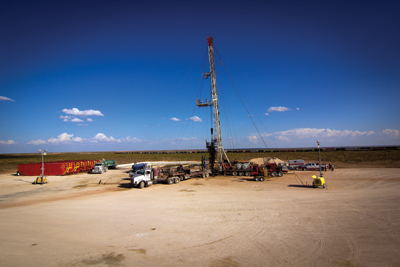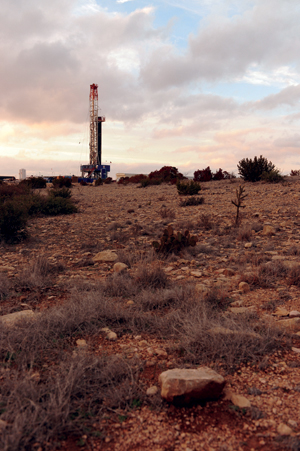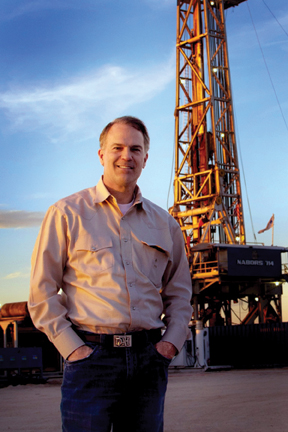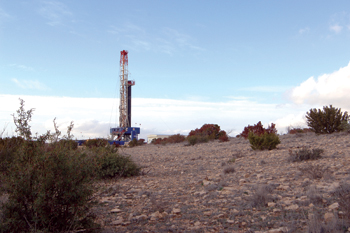 Big Oil is outside looking in. As the major oil companies return from offshore and overseas to American fields to grab a piece of the shale revolution, a revolutioncreated by independent oil and gas companies—largely in Texas and New Mexico—the Bigs find that the independents sit upon the leaseholds they (the majors) once controlled.
Big Oil is outside looking in. As the major oil companies return from offshore and overseas to American fields to grab a piece of the shale revolution, a revolutioncreated by independent oil and gas companies—largely in Texas and New Mexico—the Bigs find that the independents sit upon the leaseholds they (the majors) once controlled.
And notice: where deal-making is concerned, it is the Devons of the world that have the deals with the Chinese, Australians, and French. It is the Pioneers of the world that have the partnerships with India. It is Anadarko Petroleum that is doing deals with the Koreans. Chesapeake with China and with Norwegian interests. Progress Energy with Malaysia. For Big Oil, it’s a different domestic energy landscape—a world ruled by independents.
In our first installment of this series, we quoted Midland oilman Bob Landreth, who remarked that “The [major oil companies] will never again be the force they used to be 40 or 50 years ago. That is not going to happen.”
In the second installment of this series, we quoted Pioneer Natural Resources President and CEO Scott Sheffield, saying, “People would not have thought that companies like Arco and Amoco would be sold, and then all of a sudden you would have independents who are as large or larger than the Arcos and Amocos.”
And now, in this concluding installment, we look at the larger implications of this phenomenal role reversal. And at the reasons why the independents have been so strikingly successful.
The Independent Petroleum Association of America is “the national association representing the thousands of independent crude oil and natural gas explorer/producers in the United States.” Fred Lawrence, the IPAA’s vice president for economics and international affairs, told PBOG that “a lot of the majors are returning” to domestic oil fields after having toiled in deepwater offshore and foreign onshore fields.
“They are coming back to look at some of these plays that were pioneered or re-invigorated by independent oil and gas companies,” said Lawrence, who emphasized that the opinions he shared were his own, not necessarily those of the IPAA. “The Permian is a good example, just in the fact that this is a play where operators have returned and have evolved the play from the original area—from the Midland Basin—further westward into New Mexico, into the Bone Springs formation in the Delaware Basin. In addition, they’ve also discovered new geological formations and sections, such as the Wolfcamp and the Cline Shale.”
Lawrence said that the companies that are primarily responsible for these play startups or turnarounds are independents. And that “it shows they were in the unique position of having or acquiring the acreage and exploiting the play with new applications of technology. And then moving fast to prove up the play.”
Asked what has been the independents’ key to success, Lawrence summoned a word that he said had “certain old-school connotations.”
“Wildcatters… the wildcat [mentality] had a lot to do with that,” he said. “The companies are there first and they are taking exploratory and capital risks, which is the forte of these lean and nimble companies. Independents in general are not set up like the larger integrated companies that are looking for the large scale reserves and mega-projects that better suit their portfolio. So these independents have a certain focus, which is artfully deployed with technological innovation, efficient management, and less risk aversion. But they also make up in quality what they might lack in quantity.”
 He cited Chesapeake Energy as an example. “When you see the acreage position they have assembled in all these plays, it would amaze people to see this type of portfolio amassed by an independent—that an independent had over the years built itself up and invested itself in so many different new plays around the country. They were in the Barnett, Eagle Ford, Haynesville, Granite Wash, Niobrara, Mississippian Lime, the Cleveland, the Tonkawa, the Utica Shale, the Permian, the Marcellus… and they are or were holding a large acreage in some of these. It wasn’t at all by accident that they accomplished this. They were very adept at acquiring acreages in these various plays around the country, which became so prospective for oil, natural gas, and NGLs. Some of these [properties] were involved in recent sales by Chesapeake. But it is amazing how many shale plays this company has had a role in and that have evolved over a short period of time.”
He cited Chesapeake Energy as an example. “When you see the acreage position they have assembled in all these plays, it would amaze people to see this type of portfolio amassed by an independent—that an independent had over the years built itself up and invested itself in so many different new plays around the country. They were in the Barnett, Eagle Ford, Haynesville, Granite Wash, Niobrara, Mississippian Lime, the Cleveland, the Tonkawa, the Utica Shale, the Permian, the Marcellus… and they are or were holding a large acreage in some of these. It wasn’t at all by accident that they accomplished this. They were very adept at acquiring acreages in these various plays around the country, which became so prospective for oil, natural gas, and NGLs. Some of these [properties] were involved in recent sales by Chesapeake. But it is amazing how many shale plays this company has had a role in and that have evolved over a short period of time.”
And other companies too, he said.
“Companies like Devon and EOG Resources—these companies have been successful from the beginning in the shale gas plays and have grown to utilize that experience in the tight oil plays. Devon has been successful in British Columbia, Central Alberta, and Saskatchewan too. They are proliferating the shale model ‘continentally,’ going [out] from the United States and investing more in Canada.”
Boots on the Ground
The ground-level perspective of an actual independent operator—in this case, David Arrington, head of Midland-based David H. Arrington Oil and Gas, tracks mostly with the thinking of an analyst like Lawrence, but with a decidedly boots-on-the-ground outlook. Arrington shared what it is like to be an independent and what makes these operators special.
It was as far back as 2004, nearly a decade ago, when Arrington began to sense the larger implications of what might be unfolding in the independents’ fields of operations. But even then the view was hazy.
“I drilled the fourth horizontal well in Johnson County,” Arrington said. “Johnson County was kind of a step out from the Barnett Shale. And it turned out to be a success. We knew there was gas there and we knew it would produce but I didn’t know it would turn out as good as it did. But sitting there on my first well there, the White Wing Coachman [Arrington Oil names all its wells after fly lures], I never would have guessed all the things that have [since] happened around the world—not just what has happened in the Permian or in the Barnett, but really what has happened in resource plays everywhere. It really was a paradigm shift.”
Arrington went on to drill another well, a vertical, right next to that horizontal well. This was at least partly for the purpose of “listening” to the frac job that they would perform on the horizontal. “Then you put wireline down the second well” for the purpose of employing microseismic technology. “It amounts to listening equipment. So when you frac the first well, the listening devices can show you in real time where the frac job is going. It shows you the geometry of the frac job in three dimensions. Basically, using trigonometry, listening to a cracking rock, you get a three-dimensional look at the geometry of that frac job.
“Your goal in any resource play is to rubble-ize the rock and liberate the oil or gas,” he continued.
And it was in watching this technology at work that Arrington began to see the potentialities. “So you’re sitting in that trailer watching that microseismic. And it is amazing. Before that technology came—of horizontal drilling and slickwater fracturing—none of this would be possible. But I never would have dreamed of all the things that are going on now, world-wide. This new era of oil technology is not just being applied in the Permian Basin, but the world over.”
Arrington, whose father was a school principal, has “teaching in his blood” and has a natural affinity for making complicated subjects simple.
“It [fracturing] is really just a matter of three things—about the three cheapest things you could find. Water, sand, and soap,” he said. “You need soap because water, when you put it through a pump, has friction. Using soap lets you go at higher pressure so you can rubble-ize the rock. That’s all you’re doing. It sounds easy, and most genius things are easy, and I didn’t invent this, but I am copying it. It now it is being applied by everyone everywhere. It’s ubiquitous.”
Arrington came back to the Permian after his forays in Johnson County and other shale plays—back to Midland, that is, where he has headquartered his company since 1985.
Despite the multitude of advances, the actual “doing” of the business is still fraught with risk and reversals. The independent firms still encounter plenty of setbacks.
“You hear a lot about what is working but what you don’t hear about is what is not working,” Arrington said. “We actually went into the Mississippian, and Alabama, in 2006 and it was, for us, a dismal failure. We left a bunch of money in Mississippi and Alabama. I got a spanking over there. So we came back here and tried our hand at some Permian ideas. And we’re doing very well, and what is interesting is that even today, in 2013, the technology is still changing and we as an industry are getting better. That includes understanding the rock better. Other pieces of technology are coming along. Necessity is the mother of invention. There’s been a lot of innovations in drilling and in our understanding of the rock. But you’ve gotta remember—it is dark down there. There are a lot of things you gotta try, and a lot of trial and error. A lot of iterations on different techniques.”
David H. Arrington Oil and Gas will this year surpass the million-barrel mark for production in the Bone Springs alone. “We’re drilling those wells and they’re about 16,000 feet total measured depth [TMD] and cost about $8 million each,” he said. “We still have our production in the Barnett, as well as in Arkansas and in the Fayetteville Play, but the price of [natural] gas is just so low now that we’re not doing any drilling there now. We are focused on the Permian: the Wolfcamp and the Cline. Our Wolfcamp and Cline are in the Midland Basin, and our Ward County [operation] is in the Delaware Basin. Our Ward County [wells] are considered fairly deep, and are not for the faint for heart.
“Just this past weekend we lost a tool in the hole drilling,” he said. “Had to bury it and go around it. Had to put cement around it. It cost us $1.2 million just to buy the tool. That doesn’t even touch the cost of redrilling the well.”
“Things like this happen in this business. Like I said, it’s not for the faint of heart. These wells are what we call ‘manly’ wells.” [Laughs]
Arrington said that his company employs about 50. The IPAA reports that the average independent oil and gas company employs about a dozen people.
“You just keep on going and try to keep your wits about yourself, knowing all the while that any moment there are things that can hang you up. So you can’t get too serious or too cavalier. There’s a happy medium there.”
A Matter of Focus
Lee Fuller, vice president of government relations at IPAA, attributed the success of the independents in the shale plays to those companies’ particular focus. During the same period, the major oil companies had a different focus.
“I think at the time the large companies, the integrated companies, were really focused on looking for plays that were conventional plays,” Fuller said. “But at the same time, they needed those to be really large plays. So you were seeing a shifting of their production out of the United States and into frontier areas—places where they thought they could find large reservoirs that they could exploit economically. Two examples would be the deepwater offshore and Alaska.
 “The independents, meanwhile, were looking at onshore formations,” he added. “Horizontal drilling had been used in formations like the Austin Chalk. Fracturing had been around roughly 50 years, maybe more. Innovative people like George Mitchell were looking at taking much bigger risk than the big integrated companies wanted to take.
“The independents, meanwhile, were looking at onshore formations,” he added. “Horizontal drilling had been used in formations like the Austin Chalk. Fracturing had been around roughly 50 years, maybe more. Innovative people like George Mitchell were looking at taking much bigger risk than the big integrated companies wanted to take.
“From the standpoint of [independent] companies like these, if they could figure out a way to work a resource differently, then they were willing to make these trials. It took leaner organizations. However, once a few people tried it and were successful, others did it, and they all added to the knowledge base.
“They started recognizing that they were dealing with a major breakthrough in the application of technology and the development of these formations,” Fuller said. “Formations that had been viewed, in the past, as uneconomical to exploit.”









